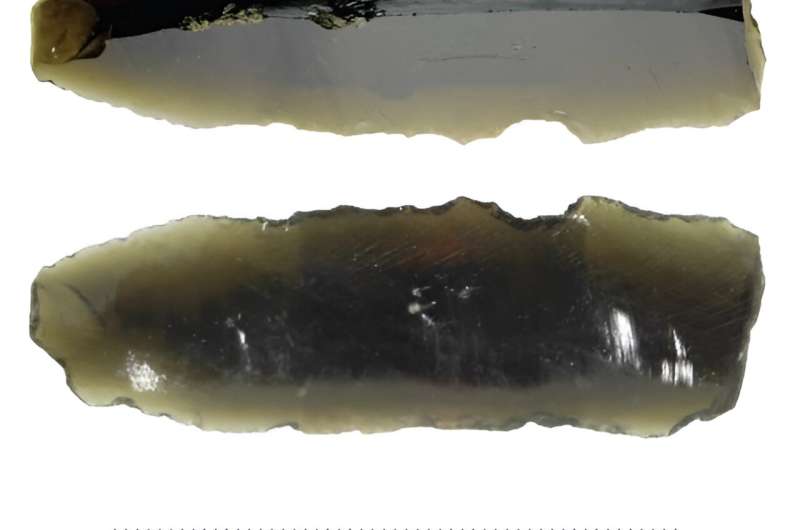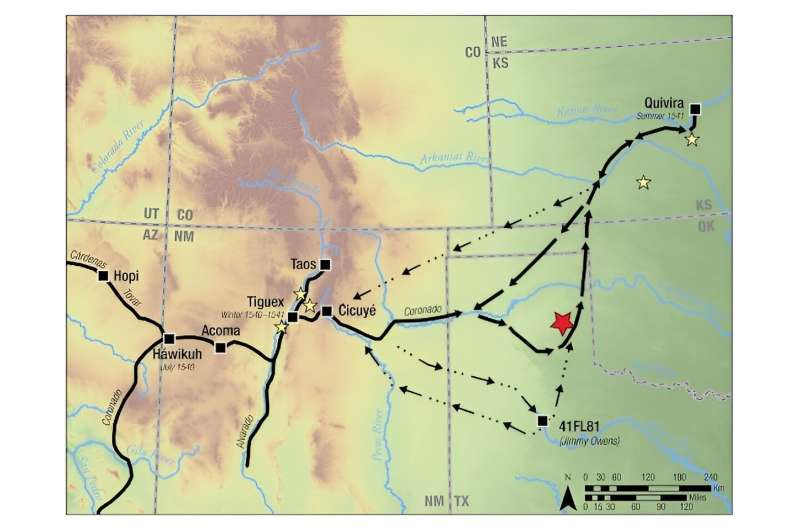This article has been reviewed according to Science X's editorial process and policies. Editors have highlighted the following attributes while ensuring the content's credibility:
fact-checked
trusted source
proofread
Artifact could be linked to Spanish explorer Coronado's expedition across Texas Panhandle

It's a small piece of obsidian, just over 5 centimeters long, likely found on a hard-scrabble piece of ranchland in the Texas panhandle. But when SMU anthropologist Matthew Boulanger looks at it, he gets a mental image of Spanish explorer Francisco Vasquez de Coronado making his way across the plains more than 470 years ago in search of a fabled city of gold.
Boulanger believes that the flaked-stone tool with its sharp edge was likely dropped by a member of Coronado's expedition, which included people indigenous to Mexico, as they trekked across parts of Texas, New Mexico, Arizona, Oklahoma, and Kansas. His theory is backed by a spectrometer analysis of the blade's chemical composition, which ties it to Central Mexico's Sierra de Pachuca mountain range, where indigenous people used obsidian to produce cutting tools until the Spanish conquest.
"This small, unassuming artifact fits all of the requirements for convincing evidence of a Coronado presence in the Texas panhandle," said Boulanger. "It is the correct form of artifact, it is fully consistent with other finds, the correct material, found in the correct location, and there are no indications of an intentional hoax."
Boulanger, director of the Archeology Research Collections in SMU's Dedman College of Humanities and Sciences, published his findings in the Journal of the North Texas Archeological Society with co-author Charlene Erwin.
Other researchers have traced the path of Spanish explorers and indigenous people from Mexico across what is now the United States through the presence of central Mexican obsidian blades; because the blades were brittle, they were discarded along the way as they broke.
Boulanger concedes that where the blade was found is subject to conjecture, as he examined the artifact after the death of its collector. But a reconstructed map of Coronado's expedition shows that the travelers likely passed by or through the ranch near McLean, Texas, where collector Lloyd Erwin grew up.

As a child, Erwin became interested in historical artifacts and started collecting items he found on the ranch. Years later, his daughter-in-law, Charlene, asked Boulanger to authenticate some of the obsidian pieces in a collection of artifacts that he had framed. Upon closer examination, Boulanger noticed a greenish tint to an obsidian piece that looked like it had been placed in the frame as an afterthought.
Using a spectrometer, Boulanger traced the obsidian to Central Mexico's Sierra de Pachuca mountain range, where indigenous people widely used obsidian to produce tools until the Spanish Conquest.
So, how did an obsidian blade from Central Mexico end up in the Texas Panhandle? There is no clear evidence for a trade network that would have connected Indigenous peoples of the Texas Panhandle to those living in Central Mexico prior to the Spanish Conquest of Mexico in the early 1500s.
Boulanger offered three theories for consideration: young Lloyd Erwin obtained the blade through trade or exchange of artifacts with other collectors, the blade is a hoax to garner attention to Erwin and his collection, or the blade was genuinely found in Texas by Erwin and is indeed an archaeological find. After piecing together Erwin's travels and interviewing his family, Boulanger believes the third hypothesis is correct.
He suspects the obsidian blade was carried northward by one of the many people indigenous to Mexico who accompanied the Coronado expedition to Quivira, near modern-day Salina, Kansas. If more corroborating evidence is uncovered near where Erwin found the blade, it could provide archaeologists more proof the artifact is part of a Coronado-related site and a clue to the expedition's trail.
"Because we know Erwin found the knife on his family ranch, we can speculate that someone on Coronado's expedition discarded it," said Boulanger. "When I talk to people collecting artifacts, I tell them to document where they find objects. Because most of us now have mobile phones, we can record GPS coordinates easily. You can now provide archaeologists precise locations, which helps them authenticate artifacts and possible lead to more discoveries."
More information: Charlene Erwin et.al., Central Mexican origin for an obsidian prismatic blade from the Texas Panhandle, Journal of the North Texas Archeological Society (2023).
Provided by Southern Methodist University




















